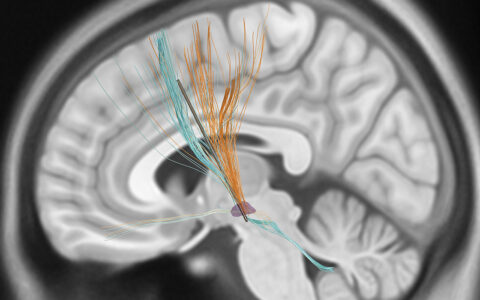The gene GABRB3 plays a critical role in early neurodevelopment. Evidence from multiple studies associated GABRB3 mutations with a variety of pediatric epilepsy symptoms and autism. A new study published in Brain provides novel insights into how GABRB3 mutations trigger a chain of events that compromise neurodevelopment.
“Our primary accomplishment was identifying the common mechanism for how mutant subunits of the protein encoded by GABRB3 prevent healthy clustering of GABAA receptors at synapses. When this clustering is compromised in early brain development, neurological disorders follow,” said Katty Kang, M.D., associate professor in the Department of Neurology and Pharmacology at Vanderbilt University Medical Center.
Kang led a Vanderbilt team in performing a functional evaluation for the study while colleagues at other institutions contributed clinical information on two patients with GABRB3 mutations. Kang’s lab is funded by the National Institute of Health and other sources, including the Vanderbilt Institute for Clinical and Translational Research and Vanderbilt Brain Institute.
A Key Protein Partnership
The neurotransmitter GABA plays a central role in the nervous system, regulating communication between nerve cells in mature brains and mediating neurotrophic signaling in the developing brain.
Proteins encoded by the GABRB3 gene are crucial to the proper assembly and trafficking of GABAA receptors to the cell surface. One of these proteins, subunit ß3, normally partners with another subunit, y2, to help GABA perform its function at synapses. If this partnership is flawed, the regulation of synapse function is impaired.
Study Design
There are over 400 mutations in GABRB3 associated with various epilepsy syndromes. Kang and colleagues first compared the impact of multiple mutations with a high throughput flow cytometry assay that evaluated the expression of each receptor subunit. They then focused on comparing wild-type GABRB3 genes to those with two mutations (N328D and E357K). They found that both mutations decreased synaptic expression of y2 subunits, which was also associated with a reduced function of the mutant β3 subunit.
Using whole gene sequencing of two epilepsy patients, they were able to rule out all other genetic causes. “We previously knew that GABRB3 mutations were associated with epilepsy and autism. Now we figured out what is going in neurons with different defective β3 subunits, and understand the mechanism underlying clinical phenotypic heterogeneity,” Kang said.
The study reports other findings that contribute to a broader understanding of the pathophysiology of epilepsy and autism:
- y2 subunits serve as markers for synaptic receptor expression levels. With mutant y2, expression was 15 to 40 percent lower than in wild-type.
- Mutant ß3 subunits have reduced receptor puncta in synapses.
- Mutant ß3 subunits have reduced inhibitory function in synapses compared to wild-type.
Looking Toward Targeted Therapies
Kang says that the findings, while solidly in the category of basic research, may help generate a therapeutic application sooner than later.
“We now understand that the mutant β3 subunits disable the function of partnering y2 subunits, which are critical for synaptic clustering. So, we have found a target. Now we have to find a way to prevent, fix or compensate for the mutation,” Kang said.
Since some neurologic conditions, like the one caused by an E357K mutation, are heritable, people who experienced pediatric epilepsy conditions and plan to have children may consult their physician to be tested for epilepsy-related mutations. Children who have epilepsy may also be tested to identify a mutation that might point toward medication management.





